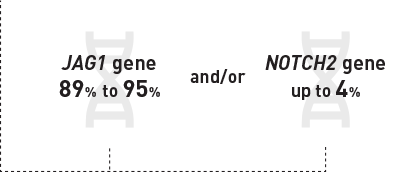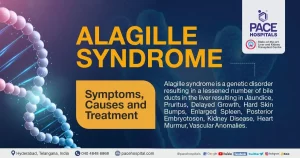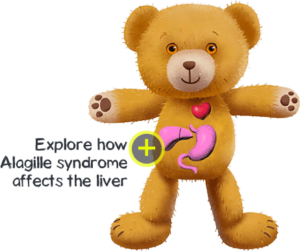Alagille syndrome is a rare, life-threatening multisystem disease that often presents in childhood. With Alagille syndrome, bile ducts are abnormally narrow, malformed, and reduced in number, which leads to toxic accumulation of bile acids in the liver and, ultimately, progressive liver disease.
Alagille syndrome is an inherited condition in which bile builds up in the liver because there are too few bile ducts to drain the bile. This results in liver damage. Your liver makes bile to help remove waste from your body. It also helps digest fats and the fat-soluble vitamins A, D, E, and K.
Alagille syndrome is an autosomal dominant disorder caused by mutations/deletions:

Disruptions in these genes cause defective bile duct morphogenesis and impaired angiogenesis, and abnormalities in skeletal, ocular, cardiovascular, and kidney development. Although 30% to 50% of individuals have an inherited pathogenic variant, the mutation occurs de novo in 50% to 70% of cases.
It is imperative to help out with early diagnosis.
Alagille syndrome affects males and females equally!
Signs and symptoms vary:
They could be from liver damage in Alagille syndrome may include a yellowish tinge in the skin and the whites of the eyes (jaundice), itchy skin, and deposits of cholesterol in the skin (xanthomas).
Alagille syndrome is also associated with several heart problems, including impaired blood flow from the heart into the lungs (pulmonic stenosis). Pulmonic stenosis may occur along with a hole between the two lower chambers of the heart (ventricular septal defect and other heart abnormalities. This combination of heart defects is called tetralogy of Fallot.
People with Alagille syndrome may have distinctive facial features including a broad, prominent forehead; deep-set eyes; and a small, pointed chin. The disorder may also affect the blood vessels within the brain and spinal cord (central nervous system) and the kidneys. Affected individuals may have an unusual butterfly shape of the bones of the spinal column (vertebrae) that can be seen in an x-ray.
Problems associated with Alagille syndrome generally become evident in infancy or early childhood. The severity of the disorder varies among affected individuals, even within the same family. Symptoms range from so mild as to go unnoticed to severe heart and/or liver disease requiring transplantation.
The symptoms and problems vary from person to person.
Treatment:
There is no specific treatment for Alagille syndrome. Management of the condition is aimed at preventing and monitoring for complications. This can include increasing the flow of bile from the liver, maintaining normal growth and development, and reducing the degree of itching.

